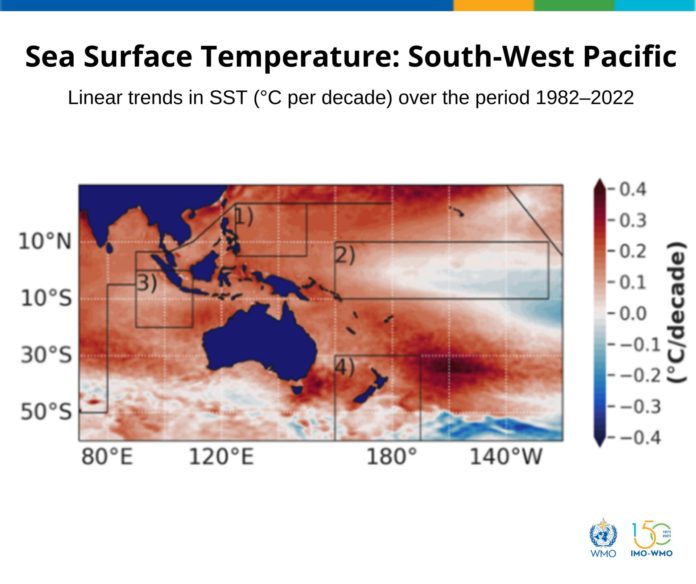L’Organisation météorologique mondiale (OMM) vient de publier un rapport préoccupant sur l’état du climat dans la région sud-ouest du Pacifique. Le document souligne les défis profonds et interconnectés auxquels la région est confrontée. Il met aussi en évidence les risques socio-économiques et les impacts sur des secteurs clés tels que l’agriculture. L’élévation du niveau de la mer menace l’avenir des îles de faible altitude, tandis que l’augmentation de la chaleur et de l’acidification des océans nuit aux écosystèmes marins vitaux et vulnérables. La nécessité urgente d’agir pour atténuer et s’adapter à ces problèmes critiques est soulignée.
Rendu public à l’occasion de la « Troisième réunion ministérielle du Pacifique sur la météorologie » et de la « Première réunion d’engagement des partenaires du développement et des donateurs à Fidji », le rapport intitulé : « Etat du climat en 2022 dans le sud-ouest du Pacifique », donne un aperçu des indicateurs climatiques ainsi que des phénomènes météorologiques extrêmes de l’année dernière.
La Niña
Selon le document, l’épisode La Niña, qui a duré trois ans, a eu une influence manifeste sur les températures en 2022. Malgré ce refroidissement temporaire, l’année a été chaude pour la région. La température moyenne était supérieure (0,2 °C à 0,3 °C) à celle enregistrée lors du dernier épisode La Niña en 2011. Le secrétaire général de l’Organisation Météorologique Mondiale (OMM), Petteri Taalas, a déclaré que le phénomène El Niño, qui a succédé à La Niña, devrait très probablement se poursuive pendant le reste de l’année. Il aura un impact important sur la région du Pacifique sud-ouest, car il est souvent associé à des températures plus élevées, à des vagues de chaleur marine et de blanchiment des coraux.
Epaisseur de la glace
L’épaisseur de la glace du glacier situé dans la partie occidentale de l’île indonésienne de Nouvelle-Guinée montre une forte diminution. De 2016 à 2022, la réduction moyenne de la superficie de la glace était d’environ 0,07 km2 par an. Les mesures de l’épaisseur de la glace indiquent une réduction de 24 mètres entre juin 2010 et début 2021. En décembre 2022 elle était estimée à six mètres.
Niveau de l’océan
Le rapport de l’OMM indique que l’élévation du niveau de l’océan dans la région Pacifique (4mm) dépasse la moyenne mondiale. Le réchauffement des océans, qui absorbent plus de 90% de l’excès de chaleur, contribue à environ 40 % de l’élévation moyenne du niveau de la mer. Il modifie les courants océaniques, les trajectoires des tempêtes et affecte les écosystèmes marins.
Victimes
En 2022, 35 catastrophes naturelles ont été signalées dans le sud-ouest du Pacifique selon la base internationale de données sur les catastrophes, dont plus de 70 % étaient des inondations. Ces événements ont causé plus de 700 décès, dont plus de 70 % étaient liés à des tempêtes en particulier aux Philippines et à Fidji. Plus de 8 millions de personnes ont été directement touchées par ces aléas.
Système d’alerte
L’alerte précoce est l’un des moyens les plus efficaces de réduire les dommages causés par les catastrophes, car elle permet aux gens de prendre des décisions en connaissance de cause en matière de sécurité alimentaire et dans d’autres secteurs. Malgré les efforts continus déployés le rapport montre qu’il reste d’importantes lacunes à combler.
Pertes économiques
En 2022, dans l’ensemble, les inondations ont causé les pertes économiques les plus élevées en Australie, avec un total de plus de 8 milliards de dollars, suivie par l’Indonésie (plus de 74 millions de dollars) et les Philippines (plus de 11 millions de dollars). Cette augmentation spectaculaire est principalement due aux inondations australiennes ainsi que celles provoquées par les tempêtes tropicales « Megi » et « Nalgae » aux Philippines.


